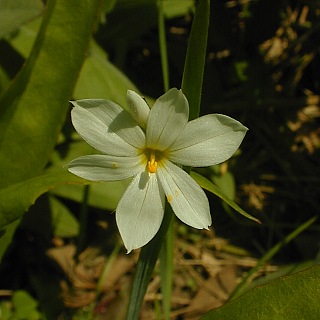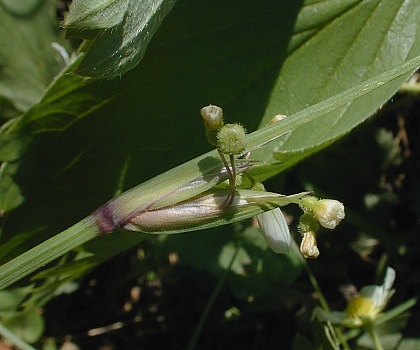Description:
This
perennial plant is ½–1' tall, consisting of a tuft of basal
leaves and flowering stalks that are grass-like in appearance. The
basal leaves are shorter than the flowering stalks; they are both
green, linear, and about 1/8" across. Each flowering stalk is narrowly
winged and terminates in a pair of flower-bearing spathes and an outer
leafy bract. Each spathe is sessile and consists of a
pair of claw-like bracts up to 1" long; these
bracts are often reddish or light brownish green. The outer leafy bract
is up to 3" long. Between the bracts of each spathe, there develops a
floppy umbel of flowers. Although an umbel has up to 6 flowers, only 1
or 2 flowers bloom at the same time. When it is fully open, each flower
is about ½" across and consists of 6 white or pale blue tepals, a
united column of yellow to orange-yellow stamens, and a green globoid
ovary that is covered with fine glandular hairs. The slender pedicel of
each flower is about ½" long. The blooming period occurs from late
spring to early summer and lasts about 3-4 weeks; the flowers usually
remain open from late morning to mid-afternoon on sunny days. There is
no noticeable floral scent. Each flower is replaced by a seed capsule
that is globoid and ridged; this capsule eventually turns brown and
contains many small seeds. The root system consists of a tuft of coarse
fibrous roots. This plant spreads by forming offsets and by reseeding
itself.
sessile and consists of a
pair of claw-like bracts up to 1" long; these
bracts are often reddish or light brownish green. The outer leafy bract
is up to 3" long. Between the bracts of each spathe, there develops a
floppy umbel of flowers. Although an umbel has up to 6 flowers, only 1
or 2 flowers bloom at the same time. When it is fully open, each flower
is about ½" across and consists of 6 white or pale blue tepals, a
united column of yellow to orange-yellow stamens, and a green globoid
ovary that is covered with fine glandular hairs. The slender pedicel of
each flower is about ½" long. The blooming period occurs from late
spring to early summer and lasts about 3-4 weeks; the flowers usually
remain open from late morning to mid-afternoon on sunny days. There is
no noticeable floral scent. Each flower is replaced by a seed capsule
that is globoid and ridged; this capsule eventually turns brown and
contains many small seeds. The root system consists of a tuft of coarse
fibrous roots. This plant spreads by forming offsets and by reseeding
itself.
Cultivation:
The preference is full sun, mesic levels of moisture, and a loamy soil,
although this species will adapt to other growing conditions. It often
adapts well to grassy areas, but dislikes competition from taller
broad-leaved forbs.
Range & Habitat:
The native White Blue-Eyed Grass is occasional to locally common in
most areas of
Illinois; it is somewhat less common in the western half of the state
(see Distribution
Map). Habitats include mesic prairies, savannas, meadows in
wooded areas, open woodlands, limestone glades, and grassy areas along
railroads. This species can be found in degraded meadows with Kentucky
Bluegrass, as well as higher quality prairies with native bunch
grasses. Occasional wildfires are probably beneficial in preventing
this species from becoming smothered by the decaying remains of taller
vegetation.
Faunal Associations:
Various kinds of bees and flower flies visit the flowers for nectar or
pollen; the bees are probably more effective at cross-pollination. I
have observed a small dark beetle gnawing on the flowers; it remains
unidentified. Little else is known about floral-faunal relationships
for this species.

Photographic
Location:
The webmaster's wildflower garden in Urbana, Illinois. In one
photograph, a long leafy bract lies above the spathes. The bracts of
the outer spathe are readily observable, while the bracts of the inner
spathe are emerging from the leafy bract.
Comments:
This is one of the more common Sisyrinchium sp. in
Illinois. White Blue-Eyed Grass can be rather variable in appearance:
one common form is short (about 6" high) with white flowers, while
another form is tall (about 12" high) with pale blue flowers. White
Blue-Eyed Grass is the only Sisyrinchium sp. in
Illinois with 2 sessile spathes at the apex of each flowering stalk.
Only one of the spathes may be evident when a flowering stalk begins to
bloom; however, both spathes (each consisting of a pair of claw-like
bracts) should be observable later during the blooming period or when
the seed capsules develop.
Other Sisyrinchium spp. produce a single sessile
spathe on each flowering stalk, or they produce spathes on long
secondary stalks (peduncles) at least occasionally. Sometimes Sisyrinchium
albidum is called Common Blue-Eyed Grass.